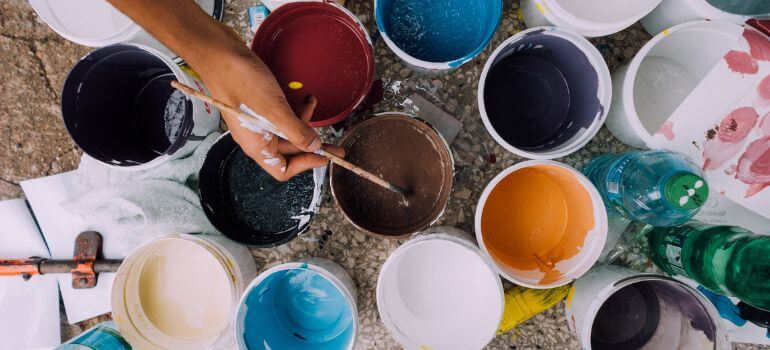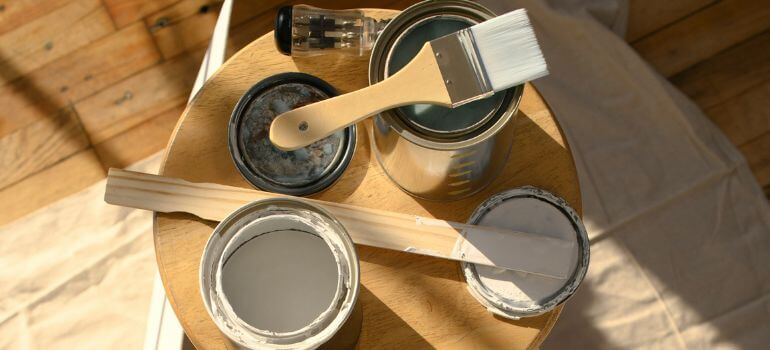Introduction
Have you ever opened a paint can, only to find the contents separated and unusable? This common dilemma raises a crucial question: How long does paint stay mixed after shaking? Understanding this can be the key to efficient and effective painting.
Understanding Paint Composition
Paint Components: Paint is more than just color; it’s a blend of pigments, binders, solvents, and additives. Each plays a role in the final appearance and durability of the paint.
Effect of Mixing: Shaking or stirring paint is essential for achieving a homogeneous mixture. It ensures that the pigments and binders are evenly distributed, providing consistency in color and texture.
The Shaking Process
Methods: Whether shaken by hand or with a mechanical mixer, the goal is to achieve a consistent mixture.
Effects on Consistency: Adequate shaking breaks down clumps and distributes components evenly, which is vital for a smooth application and finish.
Factors Influencing Paint Separation
Environmental Factors: The longevity of mixed paint can be impacted by temperature and humidity. Extreme conditions can accelerate separation.
Paint Type: Oil-based paints can separate more slowly than water-based paints, but they also have different storage requirements.
Timeframe for Mixed Paint
When it comes to the question of how long paint stays mixed after shaking, there’s no one-size-fits-all answer. The timeframe varies depending on several factors, including the type of paint, its quality, and storage conditions. However, understanding these factors can help you estimate how long your mixed paint will remain in good condition.
Oil-Based Paints: These paints are known for their durability and longer shelf life. Once mixed, oil-based paints can stay in a usable state for quite some time, often several years, if stored properly. They tend to separate less quickly than their water-based counterparts, but they are not immune to the effects of time and environmental conditions.
Water-Based Paints: Also known as latex paints, water-based paints are more prone to separation over time. On average, a well-stored, mixed water-based paint can last up to a year without significant quality degradation. However, this timeframe can be shorter if the paint is exposed to unfavorable conditions like extreme temperatures or humidity.
Factors Affecting Longevity:
- Quality of Paint: Higher quality paints often have better formulations that allow them to stay mixed longer. They may contain more effective binders and stabilizers that maintain the suspension of pigments.
- Storage Conditions: The environment where the paint is stored plays a crucial role. Paints last longer when stored in a cool, dry place. Extreme temperatures, both hot and cold, can negatively affect the paint’s lifespan. Moisture and direct sunlight can also lead to quicker degradation.
- Seal of the Container: The way the paint can is sealed impacts how long the paint stays mixed. Airtight containers prevent the solvent from evaporating and protect the paint from external contaminants.
- Age of Paint: Even unopened cans of paint don’t last forever. Over time, the components in the paint can start to degrade, affecting its ability to stay mixed.
- Frequency of Use: Paints that are frequently opened and used may have a shorter mixed lifespan compared to those that remain sealed.
Signs of Paint Separation

Recognizing when paint has begun to separate is essential for any painting project. Paint separation is a common issue, especially in cans that have been stored for an extended period. Identifying the signs early can save you from a flawed paint job and ensure optimal use of your paint. Here are key indicators to look out for:
- Layer of Solvent on Top: One of the most noticeable signs of paint separation is the presence of a clear or slightly colored liquid layer at the top of the can. This layer is usually the solvent or thinner that has separated from the pigments and binders.
- Solidified or Thickened Components at the Bottom: Over time, the heavier components of the paint, like pigments and binders, tend to settle at the bottom of the can. If these components have solidified or become very thick, it’s a clear sign of separation.
- Inconsistent Texture and Color: When you stir the paint, observe the consistency. If it appears lumpy, gritty, or if the color seems uneven, these are signs that the paint has not retained its homogeneity.
- Foul Odor: An off or sour smell emanating from the paint can indicate spoilage or bacterial growth, often a consequence of prolonged storage under inappropriate conditions.
- Difficulty in Stirring: If the paint is hard to stir and doesn’t return to a smooth consistency after thorough mixing, it’s likely that separation has occurred and the paint might be past its usable state.
- Rusting Inside the Can: Rust inside the can, especially in metal containers, can contaminate the paint, leading to color changes and separation.
- Changes in Viscosity: Paint that feels too thin or too thick compared to its original consistency is a sign of separation. The solvent and binders might have separated, altering the viscosity of the paint.
- Visible Clumps or Skins: Sometimes, a skin or clumps can form on the surface of the paint, especially if the can wasn’t sealed properly. Clumps within the paint also indicate that it hasn’t been stored correctly.
What to Do If You Notice Separation:
- For mild separation, thorough stirring or shaking can often reincorporate the separated components.
- If the paint has solidified at the bottom or developed a foul odor, it’s likely beyond rescue and should be disposed of properly.
- Always test separated and then mixed paint on a small area before applying it to a larger surface to ensure it still performs as expected.
Best Practices for Paint Storage
Proper storage of paint is crucial to extend its shelf life, maintain its quality, and ensure it stays mixed for as long as possible. By following best practices for storing paint, you can avoid common issues like separation, spoilage, and degradation. Here are some key tips to keep in mind:
- Keep Paint in a Cool, Dry Place: Extreme temperatures, both hot and cold, can adversely affect paint. Store paint in a location where the temperature is stable and moderate. Avoid places like outdoor sheds or garages if they are prone to temperature fluctuations.
- Avoid Direct Sunlight: Sunlight can cause the paint to heat up and degrade. It can also lead to color fading. Store paint in a dark or shaded area to prevent these issues.
- Ensure a Tight Seal: After using paint, make sure the lid is closed tightly. This prevents air from getting in, which can dry out the paint and lead to a skin forming on the surface. Use a rubber mallet to gently tap the lid closed if necessary, ensuring an airtight seal.
- Store Paint Cans Upside Down: This might seem counterintuitive, but storing paint cans upside down can create a better seal and prevent air from entering the can. Just ensure the lid is on tightly to avoid leaks.
- Prevent Rust: For metal paint cans, rust can be a problem. To prevent rusting, which can contaminate paint, store cans in a dry environment. You can also place a plastic wrap under the lid before sealing to create an additional barrier.
- Label Your Paint Cans: Write down the date of purchase and the room or project for which the paint was used. This makes it easier to track how old the paint is and for what purpose it was intended.
- Avoid Frequent Temperature Changes: Repeatedly moving paint between different environments can cause it to degrade faster. Try to find a storage spot where the paint can remain undisturbed until you need it again.
- Keep Away from Extreme Humidity: High humidity can lead to mold and mildew growth in paint. Store paint in a dry area to prevent this issue.
- Check Regularly: Periodically inspect your stored paint. Look for signs of separation or spoilage and stir it occasionally to keep it well mixed.
- Dispose of Old or Unused Paint Properly: If you have paint that’s past its prime or no longer needed, dispose of it responsibly. Check with your local waste management services for guidelines on disposing of paint.
Re-mixing Paint: When and How
If your paint has separated, don’t despair. Often, a thorough shake or stir can restore its consistency. However, if the paint has hardened or developed an off odor, it might be past saving.
Professional Insights
Experienced painters recommend investing in good quality paint and proper storage containers to maximize the paint’s shelf life.
The Role of Paint Additives
Certain additives can improve the stability of paint, helping it stay mixed for longer. However, use these judiciously as they can alter the paint’s drying time and finish.
DIY Tips for Perfect Paint Application
A well-prepared surface is the canvas for a perfect paint job. Ensure the surface is clean, dry, and primed if necessary. When applying, use even strokes for a uniform finish.
Safety and Environmental Considerations
Proper disposal of paint is important for environmental safety. Never pour paint down the drain; instead, check with local waste management for disposal guidelines.
Cost Implications
Understanding the shelf life of mixed paint can save money in the long run. It reduces waste and the need for frequent repurchases.
Innovative Tools and Gadgets
There are gadgets available that can help maintain the consistency of your paint, such as automatic stirrers and advanced storage containers.
Conclusion
Understanding how long paint stays mixed after shaking is crucial for any painting project. By considering the type of paint, storage conditions, and proper mixing techniques, you can ensure your paint remains in perfect condition for when you need it.
FAQs
Yes, extreme temperatures can accelerate the separation process in paint.
Generally, oil-based paints have a longer shelf life once mixed compared to water-based paints.
Look for signs like a solvent layer on top, solid components at the bottom, or a lumpy consistency.
Yes, certain additives can improve paint stability, but they might alter other properties like drying time.
Store paint in a cool, dry place and ensure the lid is tightly sealed to prevent air from entering.



